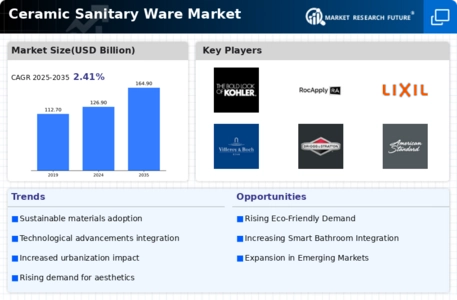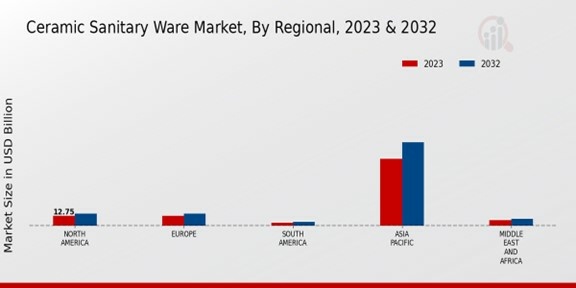Rising Urbanization
The Global Ceramic Sanitary Ware Market Industry is experiencing growth driven by increasing urbanization. As more individuals migrate to urban areas, the demand for residential and commercial properties rises, subsequently increasing the need for sanitary ware products. Urban centers often prioritize modern infrastructure, which includes high-quality ceramic sanitary ware. This trend is particularly evident in developing countries, where urban populations are projected to grow significantly. The market is expected to reach 126.9 USD Billion in 2024, reflecting the impact of urbanization on construction and renovation activities.
Sustainability Trends
Sustainability is becoming a pivotal driver in the Global Ceramic Sanitary Ware Market Industry. Consumers are increasingly favoring eco-friendly products, prompting manufacturers to adopt sustainable practices in production. This includes using recycled materials and reducing water consumption during manufacturing processes. The shift towards sustainability not only appeals to environmentally conscious consumers but also aligns with global initiatives aimed at reducing carbon footprints. As a result, companies that prioritize sustainability are likely to capture a larger market share, contributing to the projected growth of the industry to 164.9 USD Billion by 2035.
Market Growth Projections
The Global Ceramic Sanitary Ware Market Industry is poised for substantial growth, with projections indicating a rise from 126.9 USD Billion in 2024 to 164.9 USD Billion by 2035. This growth trajectory suggests a compound annual growth rate (CAGR) of 2.41% from 2025 to 2035. The increasing demand for innovative and sustainable sanitary ware solutions, coupled with urbanization and rising disposable incomes, is likely to drive this expansion. As manufacturers adapt to changing consumer preferences and regulatory requirements, the market is expected to evolve, presenting new opportunities for stakeholders.
Technological Advancements
Technological innovations are significantly influencing the Global Ceramic Sanitary Ware Market Industry. Advancements in manufacturing techniques, such as 3D printing and digital glazing, enhance product quality and design flexibility. These technologies enable manufacturers to produce intricate designs and customized solutions that cater to diverse consumer preferences. Furthermore, smart sanitary ware, integrated with IoT technology, is gaining traction, offering features like water-saving mechanisms and automated cleaning. As these technologies evolve, they are expected to attract a broader customer base, thereby supporting the market's growth trajectory.
Increased Disposable Income
The rise in disposable income across various regions is a notable driver for the Global Ceramic Sanitary Ware Market Industry. As consumers experience improved financial conditions, they are more inclined to invest in home renovations and upgrades, including high-quality sanitary ware. This trend is particularly pronounced in emerging economies, where a growing middle class is seeking modern amenities. The increased spending power is likely to boost demand for premium ceramic sanitary products, contributing to the market's anticipated growth rate of 2.41% CAGR from 2025 to 2035.
Government Initiatives and Regulations
Government initiatives aimed at improving sanitation and hygiene standards are propelling the Global Ceramic Sanitary Ware Market Industry. Many countries are implementing regulations that mandate the use of high-quality sanitary ware in public and private facilities. These initiatives are often part of broader public health campaigns, emphasizing the importance of sanitation in preventing disease. Consequently, the demand for ceramic sanitary ware is likely to increase as compliance with these regulations becomes essential. This regulatory environment is expected to further stimulate market growth, aligning with the industry's projected expansion.














